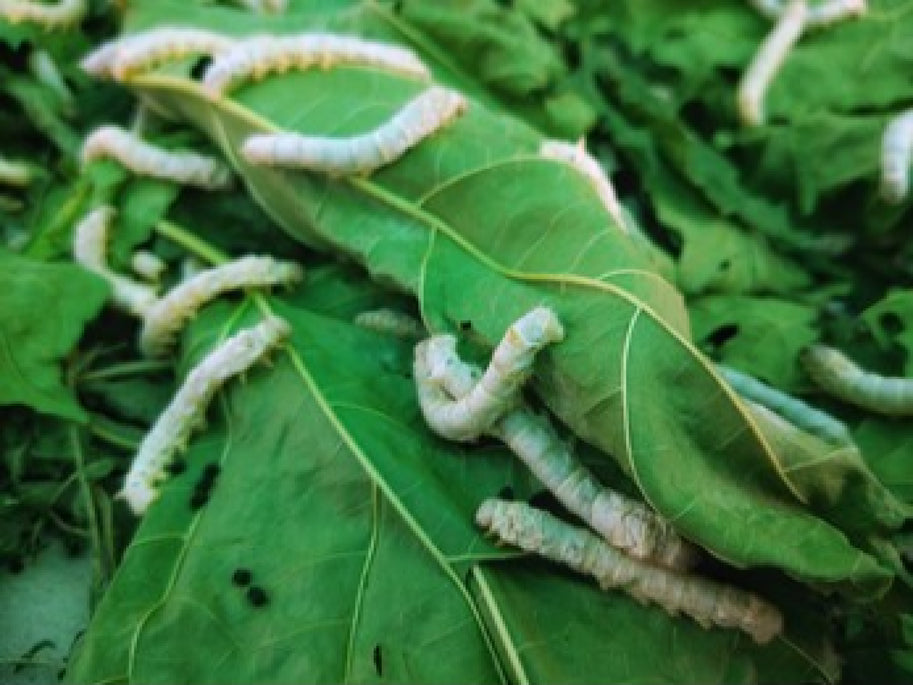For many years the humble Silkworm has been a popular classroom project, Silkworms are often a very common “first pet” without realising they are a pet! They are a great creature to learn about and observe the life cycle.
How much do we know about Silkworms?
Silkworms are the larva of a moth (Bombyx mori) that are used in the production of commercial silk, with the silk sourced from the cocoons of the moth.
Life Cycle
Silkworms take about 6-8 weeks to grow at which time, they will spin a cocoon; in the summer months this can be slightly shorter. It takes about ten days for the silkworm pupae to turn into a moth and emerge from the cocoon. Once the moth emerges, the silkworm moth generally lives for about 3 days, but can live up to ten days.
While these moths do not typically fly, the male moths may fly briefly in search of a female.
Shortly after the male and female moths have mated, the female will lay her eggs (anywhere between 200 – 500). As the moths do not eat or drink, they die naturally soon after laying their eggs. The males may mate with more than one female before they die.

The eggs remain in a state called “diapause” until they have been through a cold period (winter). When the temperature rises in spring they begin to develop and hatch ready to eat the first tender shoots on the Mulberry trees or the chow. Given the availability of chow, the eggs can be forced into thinking its winter, by placing them in a fridge for 3 months. After removing from the fridge, the eggs take approximately 10-12 days to hatch, and the lifecycle is complete.
The best time to begin rearing Silkworms is after the start of Spring or check when your Mulberry Tree has begun to sprout.
Housing
After hatching, your new Silkworms need care and attention for the next 20-35 days. The more that they are fed, the quicker they will hatch.
Housing your new Silkworms can be easy. Small numbers (50-100) can easily be housed in a shoebox or if you’d like to be able to watch them you can get a small acrylic fish tank with small air holes on the top.
As the Silkworms increase in size, it’s important to make sure that you spread them out, so that they can live comfortably, if they are too cramped it increases the chance of contracting diseases. Silkworms – just like humans, are susceptible to diseases. So, make sure that you are removing their frass (droppings) each day.
Temperature
For optimal growth, it is important to maintain a constant temperature range of between 24-28C.
Feeding
Silkworms typically feed on the leaves of the mulberry tree, however, recently artificial Mulberry food commonly known as ‘Silkworm Chow’ or ‘chow’ has become commercially available, which is made from powdered mulberry leaves. This artificial chow has resulted in the ability to produce Silkworms year-round, whether or not you have access to a Mulberry tree, as traditionally silkworms were only available seasonally.
Mulberry leaves should be added at least once per day. Ideally, give leaves two-three times per day when the Silkworms reach full size. Feed them once in the morning, once at midday, and once in the evening (if it’s a hot day and leaves wilt, swap them around more frequently).
After 25-30 days of looking after your Silkworms, they will start to eat more Mulberry Leaves than ever. Soon after, the Silkworms will be ready to start cocooning – reaching over x10,000 times their original weight!
Silkworms receive all their water requirements from their food and as a result do not require additional water.
Removal of waste
Open the lid (if housed in a plastic container) and discard the waste daily, not only the frass but any uneaten or dried out leaves.
Silkworms are susceptible to bacteria and mould therefore wash your hands before handling silkworms from the container. If any worms die remove them from the container immediately. It is also important to keep the container for your silkworms clean.
If keeping your silkworms in a shoebox, we recommend using a piece of paper towel as a ‘sheet’, so that you can simply remove the sheet with the waste material as needed. If using plastic tubs or glass terrariums it is important that they are cleaned thoroughly with soap and water and dried completely before the silkworms are placed in them. Again, paper towel can assist to keep the worm’s moisture free.
Speak to the pet experts at your local Just For Pets independent pet store, they will be able to help you select the required housing and food to keep ensure your silkworms are at their best, you might even get some silk from them!
Fun Facts
- Silkworms really do produce silk
- A female month will lay between 200 – 500 eggs
- Silkworm eggs can be refrigerated to mimic winter for a quicker hatching period
- You can buy ‘chow’ which is special food for Silkworms made from Mulberry Leaves
- Their poo is called frass!


.jpg?v=1667275445700&options=w_600)



